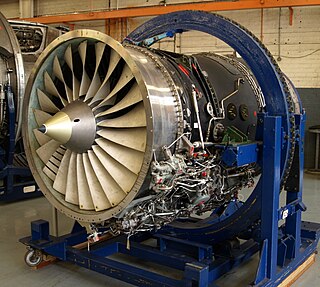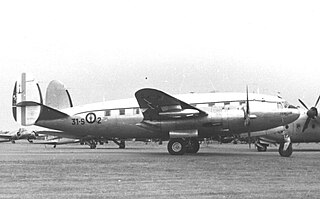
The Rolls-Royce Olympus was the world's first two-spool axial-flow turbojet aircraft engine design, dating from November 1946, although not the first to run or enter service. It was originally developed and produced by Bristol Aero Engines. First running in 1950, its initial use was as the powerplant of the Avro Vulcan V bomber. The design was further developed for supersonic performance as part of the BAC TSR-2 programme. Later it saw production as the Rolls-Royce/Snecma Olympus 593, the powerplant for Concorde SST. Versions of the engine were licensed to Curtiss-Wright in the US as the TJ-32 or J67 and the TJ-38 'Zephyr'. The Olympus was also developed with success as marine and industrial gas turbines.

The Rolls-Royce RB.183 Tay is a medium-bypass turbofan engine, developed from the RB.183 Mk 555 Spey core and using a fan scaled directly from the Rolls-Royce RB.211-535E4 to produce versions with a bypass ratio of 3.1:1 or greater. The IP compressor and LP turbine were designed using technology from the RB.211 programme. The engine was first run in August 1984. The Tay 650 had a new HP turbine which incorporated new technology which had been proven with the RB.211-535E4. This engine also had a new combustor for improved durability. The Tay family is used on a number of airliners and larger business jets, including the Gulfstream IV family, Fokker 70 and Fokker 100, with a later version being used to re-engine Boeing 727-100s.

The Rolls-Royce Spey is a low-bypass turbofan engine originally designed and manufactured by Rolls-Royce that has been in widespread service for over 40 years. A co-development version of the Spey between Rolls-Royce and Allison in the 1960s is the Allison TF41.

The Pratt & Whitney J57 is an axial-flow turbojet engine developed by Pratt & Whitney in the early 1950s. The J57 was the first 10,000 lbf (45 kN) thrust class engine in the United States. The J57/JT3C was developed into the J75/JT4A turbojet, JT3D/TF33 turbofan, and PT5/T57 turboprop. The J57 and JT3C saw extensive use on fighter jets, jetliners, and bombers for many decades.

The Rolls-Royce RB.41 Nene is a 1940s British centrifugal compressor turbojet engine. The Nene was a complete redesign, rather than a scaled-up Rolls-Royce Derwent with a design target of 5,000 lbf, making it the most powerful engine of its era. It was Rolls-Royce's third jet engine to enter production, and first ran less than 6 months from the start of design. It was named after the River Nene in keeping with the company's tradition of naming its jet engines after rivers.

The Rolls-Royce Avon was the first axial flow jet engine designed and produced by Rolls-Royce. Introduced in 1950, the engine went on to become one of their most successful post-World War II engine designs. It was used in a wide variety of aircraft, both military and civilian, as well as versions for stationary and maritime power.

The Rolls-Royce RB.37 Derwent is a 1940s British centrifugal compressor turbojet engine, the second Rolls-Royce jet engine to enter production. Essentially an improved version of the Rolls-Royce Welland, itself a renamed version of Frank Whittle's Power Jets W.2B, Rolls inherited the Derwent design from Rover when they took over their jet engine development in 1943. Performance over the Welland was somewhat increased and reliability dramatically improved, making the Derwent the chosen engine for the Gloster Meteor and many other post-World War II British jet designs.

The de Havilland Ghost was the de Havilland Engine Company's second turbojet engine design to enter production and the world's first gas turbine engine to enter airline (BOAC) service. A scaled-up development of the Goblin, the Ghost powered the de Havilland Venom, de Havilland Comet and SAAB 29 Tunnan.

The Pratt & Whitney J52 is an axial-flow dual-spool turbojet engine originally designed for the United States Navy, in the 40 kN class. It powered the A-6 Intruder and the AGM-28 Hound Dog cruise missile. As of 2017 the engine was still in use in models of the A-4 Skyhawk and the EA-6B Prowler.

The Snecma Atar is a French axial-flow turbojet engine built by Snecma. It was derived from the German World War II BMW 018 design, and developed by ex-BMW engineers through a progression of more powerful models. The name is derived from its original design group, Atelier technique aéronautique de Rickenbach near Lindau within the French Occupation Zone of Germany. The Atar powered many of the French post-war jet aircraft, including the Vautour, Étendard and Super Étendard, Super Mystère and several models of the Mirage.

The Dassault MD.452 Mystère is a 1950s French fighter-bomber.

The Armstrong Siddeley Viper is a British turbojet engine developed and produced by Armstrong Siddeley and then by its successor companies Bristol Siddeley and Rolls-Royce Limited. It entered service in 1953 and remained in use with the Royal Air Force, powering its Dominie T1 navigation training aircraft until January 2011.

The Dassault MD.454 Mystère IV is a 1950s French fighter-bomber aircraft, the first transonic aircraft to enter service with the French Air Force. It was used in large-scale combat in the Israeli Air Force during the 1967 Six Day War.

The Klimov VK-1 was the first Soviet jet engine to see significant production. It was developed by Vladimir Yakovlevich Klimov and first produced by the GAZ 116 works. Derived from the Rolls-Royce Nene, the engine was also built under licence in China as the Wopen WP-5.

The Rolls-Royce RB.82 Soar, also given the Ministry of Supply designation RSr., was a small, expendable British axial-flow turbojet intended for cruise missile use and built by Rolls-Royce Limited in the 1950s.

The Pratt & Whitney J48 is a turbojet engine developed by Pratt & Whitney as a license-built version of the Rolls-Royce Tay. The Tay/J48 was an enlarged development of the Rolls-Royce Nene.

The Sud-Ouest S.O.30 Bretagne was a 1940s French airliner built by Sud-Ouest.

The General Electric J73 turbojet was developed by General Electric from the earlier J47 engine. Its original USAF designation was J47-21, but with innovative features including variable inlet guide vanes, double-shell combustor case, and 50% greater airflow was redesignated J73. Its only operational use was in the North American F-86H.

The Rolls-Royce RB.145 was a British jet engine designed in the early-1960s by Rolls-Royce for use as a lightweight VTOL lift and cruise engine. Developed from the Rolls-Royce RB108 the RB.145 featured more accessories and a higher thrust rating. Six engines developed by MAN Turbo were fitted to the first prototype of the EWR VJ 101 experimental German fighter aircraft, achieving supersonic flight by July 1964.




















